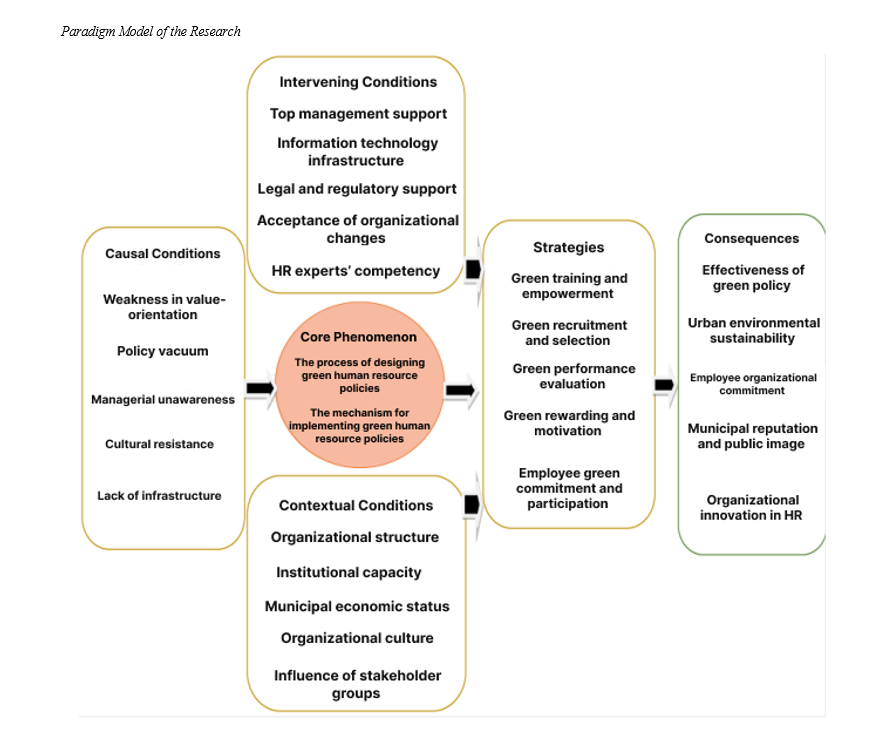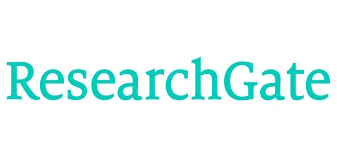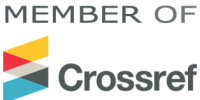Designing a Green Human Resource Management Policy-Making Model in Municipalities of the Country
Keywords:
policy-making, human resources, green human resource managementAbstract
The purpose of this study was to design a model for green human resource management (GHRM) policy-making in the country’s municipalities, using a mixed-method approach. The statistical population in the design phase included faculty members specializing in public administration and urban planning in higher education institutions, mayors and senior managers of the country’s municipalities, as well as experts and specialists in the research topic. In the validation phase, professors in the fields of public administration and urban planning at higher education institutions in Mashhad were included, and in the quantitative phase, all senior and middle managers from 13 municipal districts of Mashhad and 22 affiliated municipal organizations totaling 354 individuals participated. In the qualitative phase, 19 experts were selected through snowball sampling. In the validation phase, 17 experts were chosen using purposive sampling, and in the quantitative phase, 185 participants were selected by cluster random sampling based on Cochran’s formula. For data analysis, the qualitative phase employed the grounded theory method following Corbin and Strauss (1998), using open, axial, and selective coding with semi-structured interviews as the data collection tool. In the validation phase, the Delphi method was applied in three stages using an expert evaluation checklist analyzed in SPSS. In the quantitative phase, structural equation modeling was conducted using a 118-item questionnaire in SmartPLS software. To ensure validity and reliability in the qualitative section, necessary checks such as credibility (expert review), confirmability (expert audit), and consensus methods were applied. During the validation stage, the content of the expert evaluation checklist was confirmed for clarity and comprehensibility by several academic and organizational experts, and its reliability was established through the test–retest method with a coefficient of 0.88. In the quantitative section, questionnaire validity was confirmed through face, content, and construct validity (with convergent validity ranging from 0.557 to 0.736 and discriminant validity greater than inter-construct correlations). Reliability was verified using factor loadings of items, Cronbach’s alpha coefficients for components (ranging from 0.734 to 0.835), and composite reliability (ranging from 0.834 to 0.893). According to the findings from the qualitative and validation phases, the final model comprised 11 main categories and 27 subcategories, as follows: causal conditions (1. value-orientation weakness, 2. policy vacuum, 3. managerial unawareness, 4. cultural resistance, 5. lack of infrastructure); contextual conditions (1. organizational structure, 2. institutional capacity, 3. municipal economic situation, 4. organizational culture, 5. influence of stakeholder groups); core category (central phenomenon) (1. the process of designing green HRM policy, 2. mechanisms for implementing green HRM policy); intervening conditions (1. top management support, 2. information technology infrastructure, 3. legal and regulatory support, 4. acceptance of organizational changes, 5. HR experts’ competencies); strategies (1. green training and empowerment, 2. green recruitment and selection, 3. green performance evaluation, 4. green rewarding and motivation, 5. employee green commitment and participation); and consequences (1. effectiveness of green policy, 2. urban environmental sustainability, 3. employee organizational commitment, 4. municipal reputation and public image, 5. organizational innovation in HRM), with 118 indicators. The results of the quantitative phase confirmed that the dimensions and components of the research model were validated in the real statistical population (Mashhad Municipality).
References
Ahmad, T. (2015). Green Human Resource Practices: Implementations and Hurdles of SMEs in Pakistan. Journal of Business Studies Quarterly, 7(2), 2152-1034. https://doi.org/10.1080/23311975.2015.1030817
Akbari, M., Islambolchi, A., Hamidi, K., & Amene, M. (2024). Designing a Model for Implementing Human Resource Development Policies in the Oil Industry of Iran. Quarterly Journal of Strategic Studies in Oil and Energy, 16(61), 80-102. https://iieshrm.ir/browse.php?a_id=1655&slc_lang=en&sid=1&printcase=1&hbnr=1&hmb=1
Asghari Aghamashhad, P., Fazeli Kabirya, H., & Changiz, M. Z. (2024). Designing a Strategic Model for Green Human Resource Management. Green Development Studies. https://gmd.birjand.ac.ir/article_3355.html?lang=en
Chreif, M., & Farmanesh, P. (2022). Applying Green Human Resource Practices toward Sustainable Workplace: A Moderated Mediation Analysis. Sustainability, 14, 1-18. https://doi.org/10.3390/su14159250
Duah, E., Pakmoni, L., & Appiah-Kubi, E. (2025). Green human resource management and organizational efficiency among local assemblies: role of process innovation and knowledge sharing. Journal of Organizational Effectiveness: People and Performance, 12(1), 168-190. https://doi.org/10.1108/JOEPP-11-2023-0511
Goel, P., Mehta, S., Kumar, R., & Castaño, F. (2022). Sustainable Green Human Resource Management Practices in Educational Institutions:An Interpretive Structural Modelling and Analytic Hierarchy Process Approach. Sustainability, 14, 1-24. https://doi.org/10.3390/su141912853
Goswami, G. T., & Ranjan, K. S. (2015). Green HRM: Approach to Sustainability in Current Scenario. Journal for Studies in Management and Planning, 1(4), 250-259. https://www.google.com/url?sa=t&source=web&rct=j&opi=89978449&url=https://www.semanticscholar.org/paper/Green-HRM%253A-Approach-to-Sustainability-in-Current-Goswami-Ranjan/8d7b148a2c6b8173342b6d77ed6fea8bdd1319e1&ved=2ahUKEwjT-7Ouru2PAxV4SvEDHfmRBlUQFnoECCEQAQ&usg=AOvVaw3EQ7BTAek7nqES_c8q5RCS
Janali Zadeh Ghavini, M., Kafashpour, A., Rahimpour, A., & Mosaib, S. (2023). Designing a Conceptual Model of Dimensions and Components of Green Human Resource Management. Journal of Geography and Urban Spatial Development, 9(2), 117-136. https://jgusd.um.ac.ir/article_41415.html?lang=en
Karimi Tararani, M., Sharifzadeh, F., Sayed Naqvi, M. A., & Hosseinpour, D. (2018). The Policy-Making Model of Science and Technology Parks in the Innovation System. Journal of Innovation and Value Creation, 7(13), 40-54. http://journalie.ir/en/Article/808
Molamirzai, H. H. (2016). Presenting an Islamic Iranian Model for Implementing Cultural Policies of the Islamic Republic of Iran. Scientific Journal of Islamic Management, 24(3), 73-92. https://im.ihu.ac.ir/article_201867.html?lang=en
Najati, N., Maatoufi, A., & Farhadi Mahalli, A. (2024). Designing a Model for Categorizing Dimensions of Green Human Resource Management with a Policy-Making Approach. Green Management, 4(2), 29-41. https://doi.org/10.35912/ahrmr.v4i1.2140
Nurasa, H., Unyi, P. S. S., Abdillah, A., & Widianingsih, I. (2025). Green Leadership in Policy Making towards Sustainable Future: Systematic Critical Review and Future Direction. Pol. J. Environ. Stud., 34(1), 519-534. https://doi.org/10.15244/pjoes/186576
Rehman, M. A., Seth, D., & Shrivastava, R. L. (2016). Impact of green Manufacturig practices on organizational performance in Indian Context: An empirical study. Journal of Cleaner Production, 137, 427-448. https://doi.org/10.1016/j.jclepro.2016.07.106
Rezai, B., Zargar, S. M., & Hametian, H. (2020). Examining the Impact of Dimensions of Green Human Resource Management on Sustainable Organizational Development. Scientific Quarterly Journal of Marine Science Education, 7(20), 93-108. https://sid.ir/paper/262013/en
Sharifi, M., Modiri, M., Amiri, H., & Farzaneh, B. (2023). Presenting a Mixed-Approach Policy-Making Model in Urban Services of the Municipality. Ferdowsi Civil Engineering, 6(3), 83-98. https://civil-ferdowsi.um.ac.ir/article_44319.html?lang=en
Tavakoli, A., Hashemi, A., Sabat, A., & Saeed, R. (2018). Presenting a Structural Model of Green Human Resource Management Based on Human Resource Management Systems. Quarterly Journal of Human Resource Management Research, Imam Hussein University, 10(1), 77-103. https://hrmj.ihu.ac.ir/article_31364.html?lang=en
Vakilzadeh, J., Hezbollahi, M., & Narjili, N. (2019). Municipality Budget Summary of Mashhad: A Guide for Citizens. Municipality of Mashhad.
Zahrani, A. A. (2022). Team Creativity and Green Human Resource Management Practices' Mediating Roles in Organizational Sustainability. Sustainability, 14, 1-24. https://doi.org/10.3390/su141912827

Downloads
Published
Submitted
Revised
Accepted
Issue
Section
License
Copyright (c) 2025 Hossein Hesami, Changiz Mohammadizadeh, Mahsa Gholamhosseinzadeh (Author)

This work is licensed under a Creative Commons Attribution-NonCommercial 4.0 International License.








